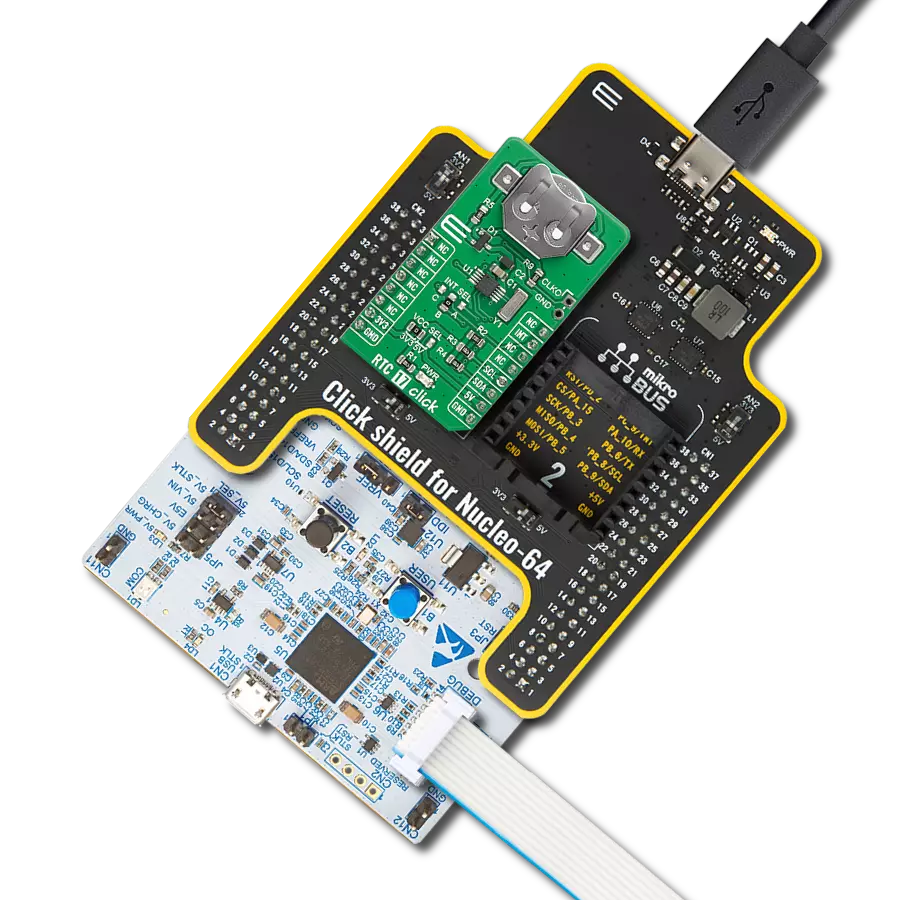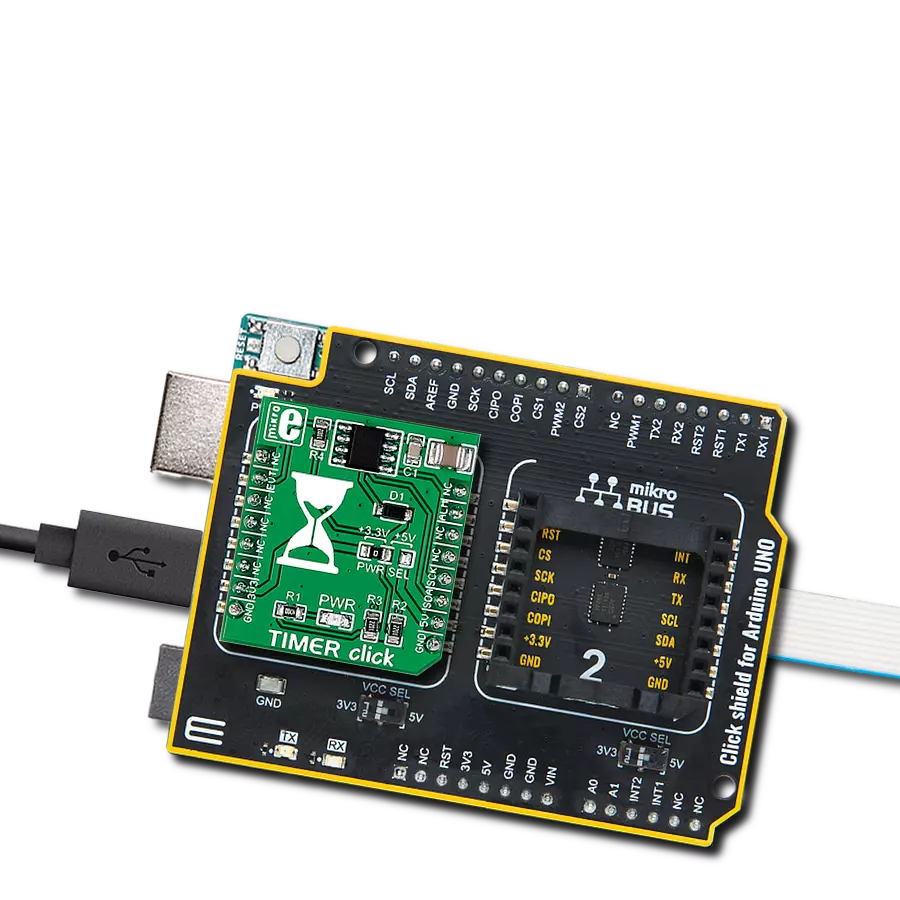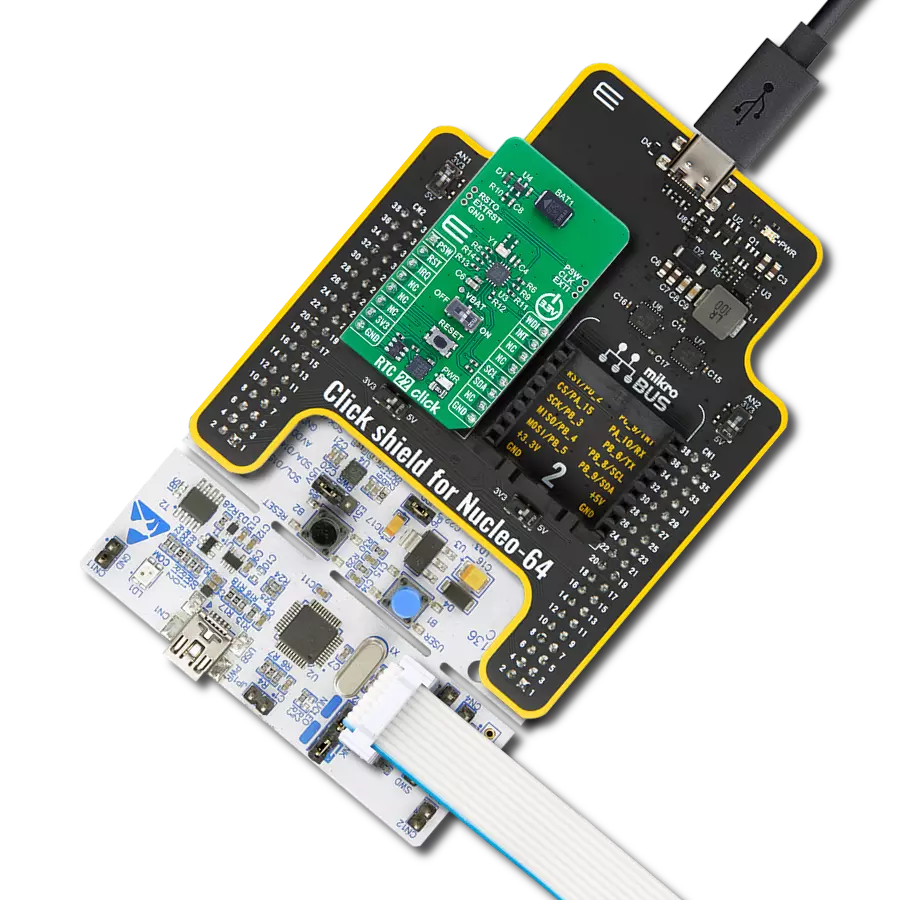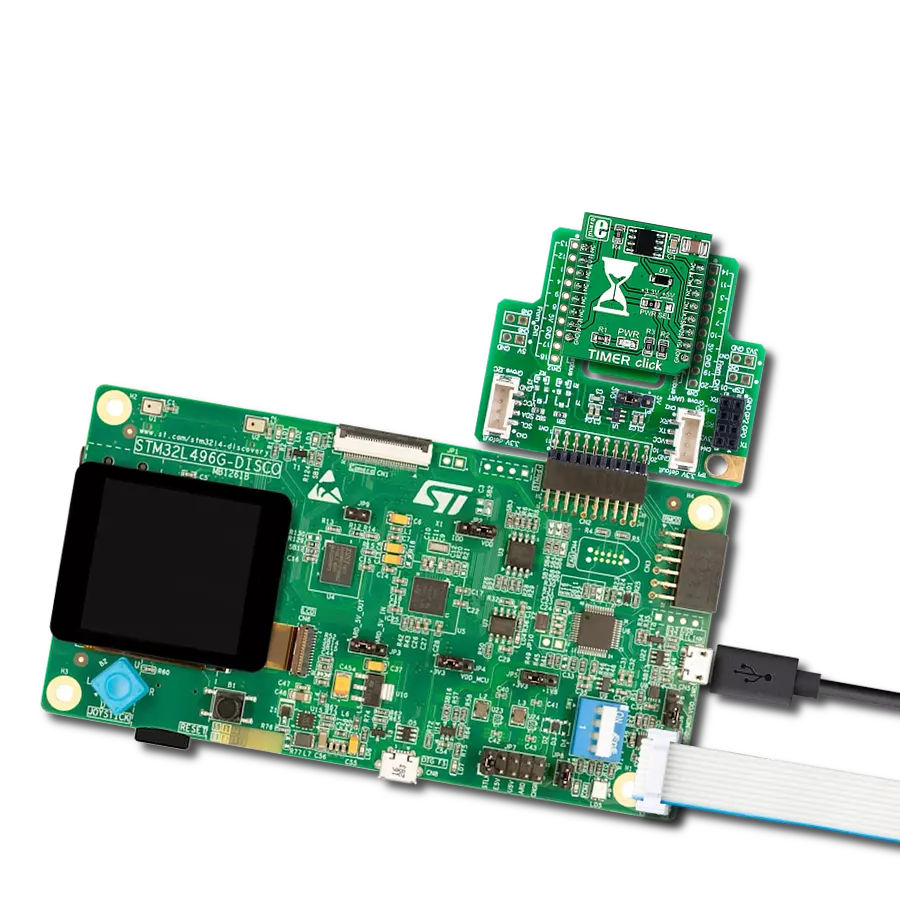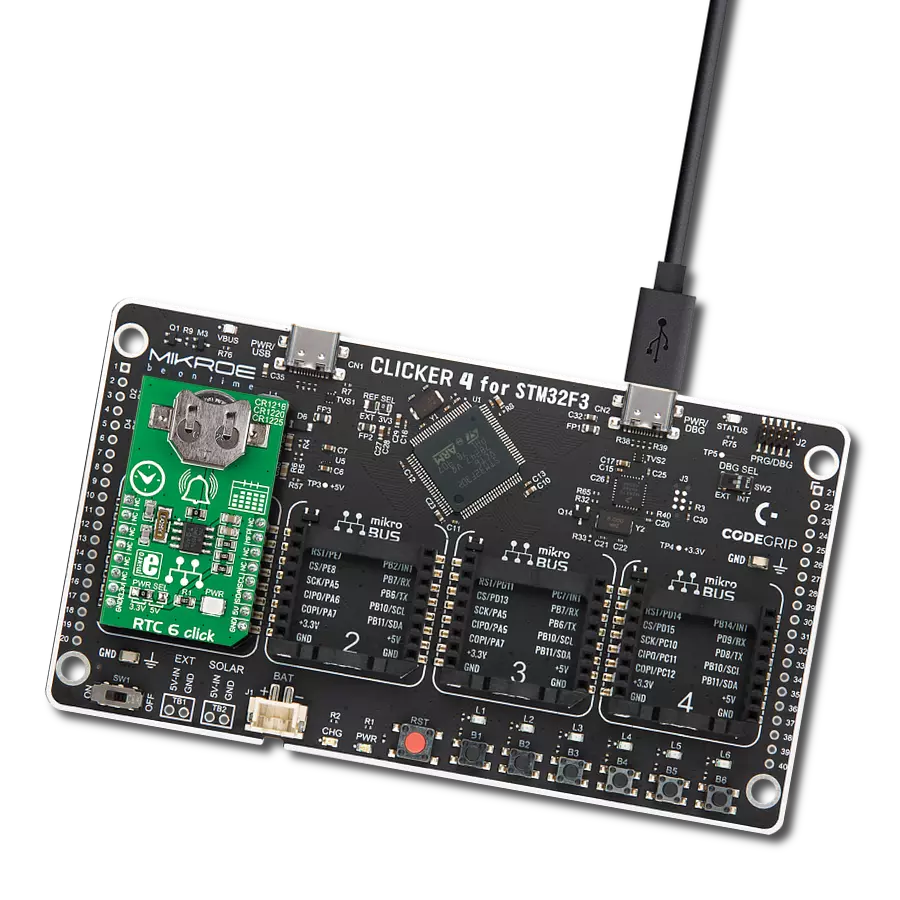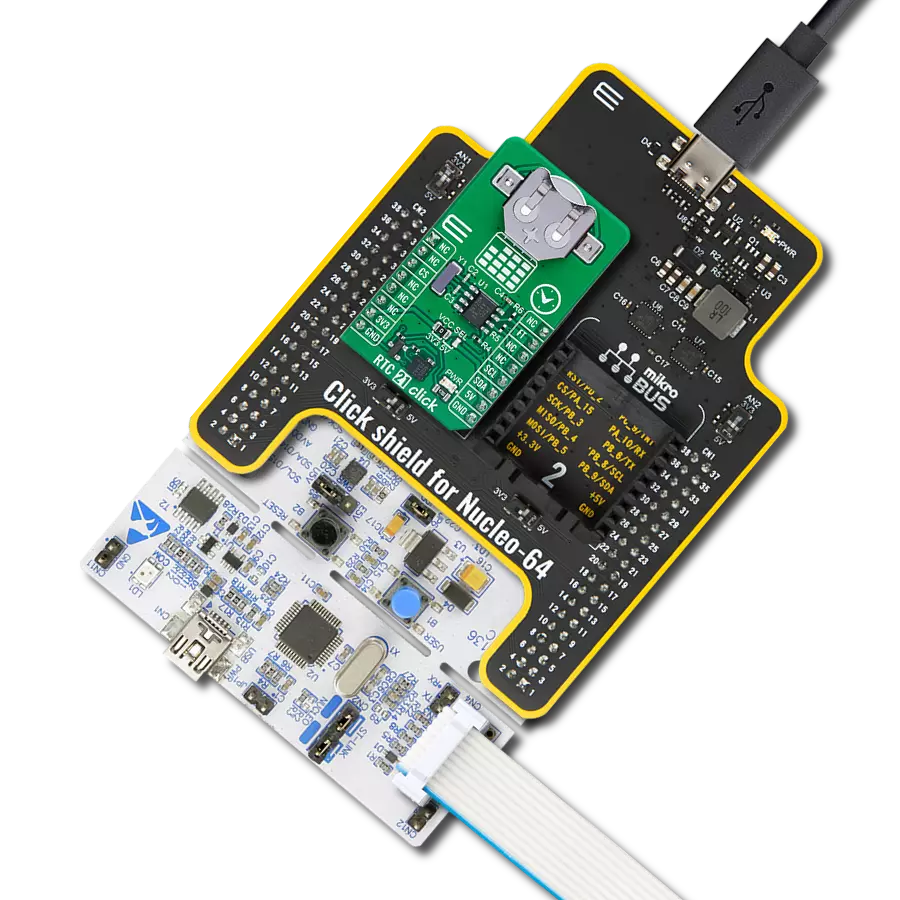Elevate your engineering solutions with our advanced real-time clock, ensuring accurate time tracking and synchronization
A
A
Hardware Overview
How does it work?
RTC 13 Click is based on the PCF2123, an SPI configurable real-time clock/calendar optimized for low-power operations from NXP Semiconductors. It contains sixteen 8-bit registers with an auto-incrementing address counter, an on-chip 32.768kHz oscillator with two integrated load capacitors, a frequency divider that provides the source clock for the RTC, and a programmable clock output. The integrated oscillator ensures year, month, day, weekday, hours, minutes, and seconds, making this Click board™ suitable for various time-keeping applications such as high-duration timers, daily alarms, and more. The PCF2123 communicates with MCU using the standard SPI serial interface with a maximum
frequency of 8MHz, where data transfers serially with a maximum data rate of 6.25 Mbit/s. An alarm and timer function is also available, providing the possibility to generate a wake-up signal on an interrupt line, available on the INT pin of the mikroBUS™ socket and indicated by a red LED marked as INT. Besides, this Click board™ also has an onboard header labeled CLKOUT, which provides a programmable square-wave output clock signal controlled by one GPIO pin, a CLE pin routed to the RTS pin, the mikroBUS™ socket. Frequencies of 32.768kHz, representing a default value of 1Hz, can be generated and used as a system and MCU clock, input to a charge pump, or oscillator calibration. Like this one, the most
common RTC configuration is a battery-backed-up, which maintains time and continues its work without interruption during a power failure. That’s why, besides the PCF2123, the RTC 13 Click has a button cell battery holder compatible with the 3000TR battery holder, suitable for 12mm Coin Cell batteries. This Click board™ can operate with either 3.3V or 5V logic voltage levels selected via the VCC SEL jumper. This way, both 3.3V and 5V capable MCUs can use the communication lines properly. Also, this Click board™ comes equipped with a library containing easy-to-use functions and an example code that can be used as a reference for further development.
Features overview
Development board
PIC18F57Q43 Curiosity Nano evaluation kit is a cutting-edge hardware platform designed to evaluate microcontrollers within the PIC18-Q43 family. Central to its design is the inclusion of the powerful PIC18F57Q43 microcontroller (MCU), offering advanced functionalities and robust performance. Key features of this evaluation kit include a yellow user LED and a responsive
mechanical user switch, providing seamless interaction and testing. The provision for a 32.768kHz crystal footprint ensures precision timing capabilities. With an onboard debugger boasting a green power and status LED, programming and debugging become intuitive and efficient. Further enhancing its utility is the Virtual serial port (CDC) and a debug GPIO channel (DGI
GPIO), offering extensive connectivity options. Powered via USB, this kit boasts an adjustable target voltage feature facilitated by the MIC5353 LDO regulator, ensuring stable operation with an output voltage ranging from 1.8V to 5.1V, with a maximum output current of 500mA, subject to ambient temperature and voltage constraints.
Microcontroller Overview
MCU Card / MCU
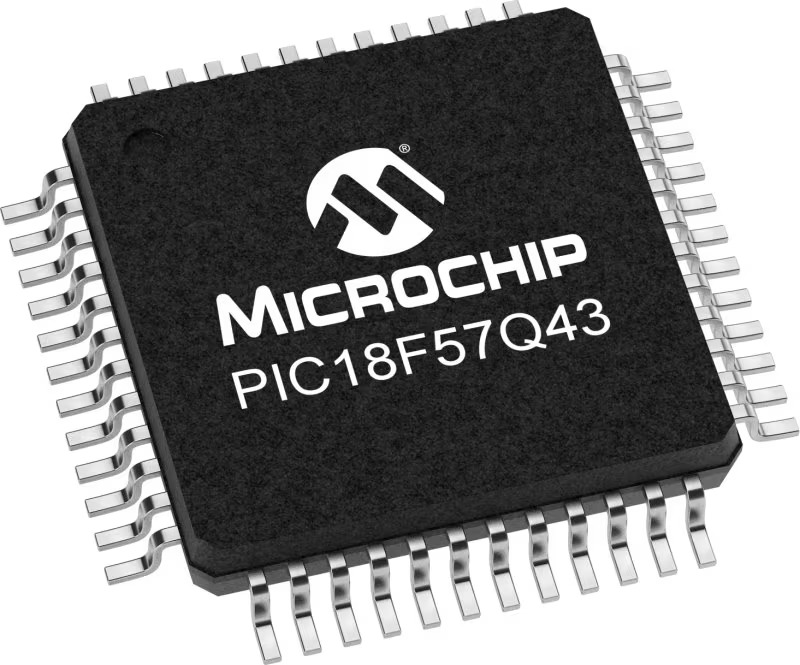
Architecture
PIC
MCU Memory (KB)
128
Silicon Vendor
Microchip
Pin count
48
RAM (Bytes)
8196
You complete me!
Accessories
Curiosity Nano Base for Click boards is a versatile hardware extension platform created to streamline the integration between Curiosity Nano kits and extension boards, tailored explicitly for the mikroBUS™-standardized Click boards and Xplained Pro extension boards. This innovative base board (shield) offers seamless connectivity and expansion possibilities, simplifying experimentation and development. Key features include USB power compatibility from the Curiosity Nano kit, alongside an alternative external power input option for enhanced flexibility. The onboard Li-Ion/LiPo charger and management circuit ensure smooth operation for battery-powered applications, simplifying usage and management. Moreover, the base incorporates a fixed 3.3V PSU dedicated to target and mikroBUS™ power rails, alongside a fixed 5.0V boost converter catering to 5V power rails of mikroBUS™ sockets, providing stable power delivery for various connected devices.
Used MCU Pins
mikroBUS™ mapper
Take a closer look
Click board™ Schematic

Step by step
Project assembly
Track your results in real time
Application Output
1. Application Output - In Debug mode, the 'Application Output' window enables real-time data monitoring, offering direct insight into execution results. Ensure proper data display by configuring the environment correctly using the provided tutorial.

2. UART Terminal - Use the UART Terminal to monitor data transmission via a USB to UART converter, allowing direct communication between the Click board™ and your development system. Configure the baud rate and other serial settings according to your project's requirements to ensure proper functionality. For step-by-step setup instructions, refer to the provided tutorial.

3. Plot Output - The Plot feature offers a powerful way to visualize real-time sensor data, enabling trend analysis, debugging, and comparison of multiple data points. To set it up correctly, follow the provided tutorial, which includes a step-by-step example of using the Plot feature to display Click board™ readings. To use the Plot feature in your code, use the function: plot(*insert_graph_name*, variable_name);. This is a general format, and it is up to the user to replace 'insert_graph_name' with the actual graph name and 'variable_name' with the parameter to be displayed.

Software Support
Library Description
This library contains API for RTC 13 Click driver.
Key functions:
rtc13_get_time- RTC 13 get time functionrtc13_set_time- RTC 13 set time functionrtc13_get_date- RTC 13 get date function
Open Source
Code example
The complete application code and a ready-to-use project are available through the NECTO Studio Package Manager for direct installation in the NECTO Studio. The application code can also be found on the MIKROE GitHub account.
/*!
* @file main.c
* @brief RTC13 Click example
*
* # Description
* This is an example that demonstrates the use of the RTC 13 Click board™.
*
* The demo application is composed of two sections :
*
* ## Application Init
* Initialization of SPI module, log UART and additional pins.
* After driver initialization and default settings,
* the app set the time to 23:59:50 and set the date to 04.08.2021.
*
* ## Application Task
* This is an example that shows the use of a RTC 13 Click board™.
* In this example, we read and display the current time and date,
* which we also previously set.
* Results are being sent to the Usart Terminal where you can track their changes.
* All data logs write on USB changes every 1 sec.
*
* @author Nenad Filipovic
*
*/
#include "board.h"
#include "log.h"
#include "rtc13.h"
static rtc13_t rtc13;
static log_t logger;
static uint8_t new_sec = 255;
static rtc13_time_t time;
static rtc13_date_t date;
void application_init ( void )
{
log_cfg_t log_cfg; /**< Logger config object. */
rtc13_cfg_t rtc13_cfg; /**< Click config object. */
/**
* Logger initialization.
* Default baud rate: 115200
* Default log level: LOG_LEVEL_DEBUG
* @note If USB_UART_RX and USB_UART_TX
* are defined as HAL_PIN_NC, you will
* need to define them manually for log to work.
* See @b LOG_MAP_USB_UART macro definition for detailed explanation.
*/
LOG_MAP_USB_UART( log_cfg );
log_init( &logger, &log_cfg );
log_info( &logger, " Application Init " );
// Click initialization.
rtc13_cfg_setup( &rtc13_cfg );
RTC13_MAP_MIKROBUS( rtc13_cfg, MIKROBUS_1 );
err_t init_flag = rtc13_init( &rtc13, &rtc13_cfg );
if ( SPI_MASTER_ERROR == init_flag )
{
log_error( &logger, " Application Init Error. " );
log_info( &logger, " Please, run program again... " );
for ( ; ; );
}
rtc13_default_cfg ( &rtc13 );
log_info( &logger, " Application Task " );
Delay_ms ( 100 );
date.weekday = 3;
date.day = 4;
date.month = 8;
date.year = 21;
rtc13_set_date( &rtc13, date );
Delay_ms ( 100 );
time.hours = 23;
time.min = 59;
time.sec = 50;
rtc13_set_time( &rtc13, time );
Delay_ms ( 100 );
}
void application_task ( void )
{
rtc13_get_time( &rtc13, &time );
Delay_ms ( 1 );
rtc13_get_date( &rtc13, &date );
Delay_ms ( 1 );
if ( time.sec != new_sec )
{
log_printf( &logger, " Date : %.2d-%.2d-%.2d\r\n", ( uint16_t ) date.day, ( uint16_t ) date.month, ( uint16_t ) date.year );
log_printf( &logger, " Time : %.2d:%.2d:%.2d\r\n", ( uint16_t ) time.hours, ( uint16_t ) time.min, ( uint16_t ) time.sec );
log_printf( &logger, "- - - - - - - - - - - -\r\n" );
new_sec = time.sec;
Delay_ms ( 1 );
}
}
int main ( void )
{
/* Do not remove this line or clock might not be set correctly. */
#ifdef PREINIT_SUPPORTED
preinit();
#endif
application_init( );
for ( ; ; )
{
application_task( );
}
return 0;
}
// ------------------------------------------------------------------------ END
Additional Support
Resources
Category:RTC




















